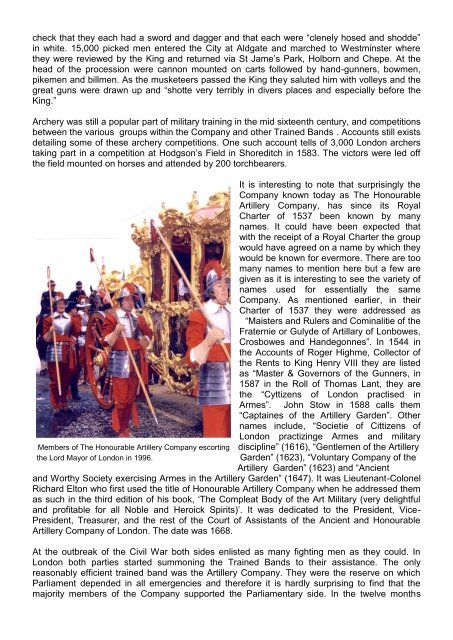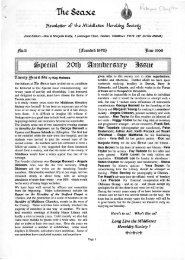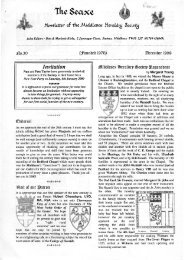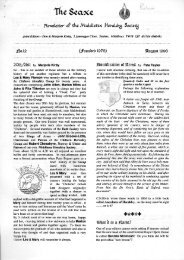No.57 - Middlesex Heraldry Society
No.57 - Middlesex Heraldry Society
No.57 - Middlesex Heraldry Society
Create successful ePaper yourself
Turn your PDF publications into a flip-book with our unique Google optimized e-Paper software.
check that they each had a sword and dagger and that each were “clenely hosed and shodde”<br />
in white. 15,000 picked men entered the City at Aldgate and marched to Westminster where<br />
they were reviewed by the King and returned via St Jame‟s Park, Holborn and Chepe. At the<br />
head of the procession were cannon mounted on carts followed by hand-gunners, bowmen,<br />
pikemen and billmen. As the musketeers passed the King they saluted him with volleys and the<br />
great guns were drawn up and “shotte very terribly in divers places and especially before the<br />
King.”<br />
Archery was still a popular part of military training in the mid sixteenth century, and competitions<br />
between the various groups within the Company and other Trained Bands . Accounts still exists<br />
detailing some of these archery competitions. One such account tells of 3,000 London archers<br />
taking part in a competition at Hodgson‟s Field in Shoreditch in 1583. The victors were led off<br />
the field mounted on horses and attended by 200 torchbearers.<br />
It is interesting to note that surprisingly the<br />
Company known today as The Honourable<br />
Artillery Company, has since its Royal<br />
Charter of 1537 been known by many<br />
names. It could have been expected that<br />
with the receipt of a Royal Charter the group<br />
would have agreed on a name by which they<br />
would be known for evermore. There are too<br />
many names to mention here but a few are<br />
given as it is interesting to see the variety of<br />
names used for essentially the same<br />
Company. As mentioned earlier, in their<br />
Charter of 1537 they were addressed as<br />
“Maisters and Rulers and Cominalitie of the<br />
Fraternie or Gulyde of Artillary of Lonbowes,<br />
Crosbowes and Handegonnes”. In 1544 in<br />
the Accounts of Roger Highme, Collector of<br />
the Rents to King Henry VIII they are listed<br />
as “Master & Governors of the Gunners, in<br />
1587 in the Roll of Thomas Lant, they are<br />
the “Cyttizens of London practised in<br />
Armes”. John Stow in 1588 calls them<br />
“Captaines of the Artillery Garden”. Other<br />
names include, “Societie of Cittizens of<br />
London practizinge Armes and military<br />
Members of The Honourable Artillery Company escorting discipline” (1616), “Gentlemen of the Artillery<br />
the Lord Mayor of London in 1996. Garden” (1623), “Voluntary Company of the<br />
Artillery Garden” (1623) and “Ancient<br />
and Worthy <strong>Society</strong> exercising Armes in the Artillery Garden” (1647). It was Lieutenant-Colonel<br />
Richard Elton who first used the title of Honourable Artillery Company when he addressed them<br />
as such in the third edition of his book, „The Compleat Body of the Art Military (very delightful<br />
and profitable for all Noble and Heroick Spirits)‟. It was dedicated to the President, Vice-<br />
President, Treasurer, and the rest of the Court of Assistants of the Ancient and Honourable<br />
Artillery Company of London. The date was 1668.<br />
At the outbreak of the Civil War both sides enlisted as many fighting men as they could. In<br />
London both parties started summoning the Trained Bands to their assistance. The only<br />
reasonably efficient trained band was the Artillery Company. They were the reserve on which<br />
Parliament depended in all emergencies and therefore it is hardly surprising to find that the<br />
majority members of the Company supported the Parliamentary side. In the twelve months














